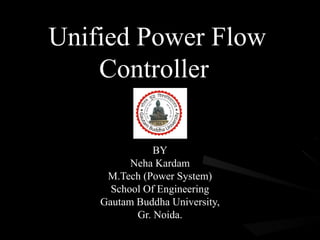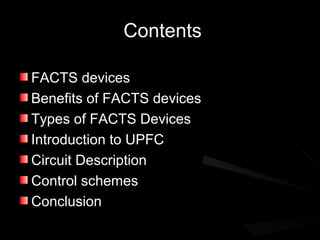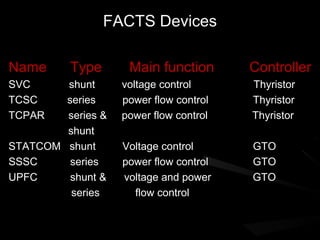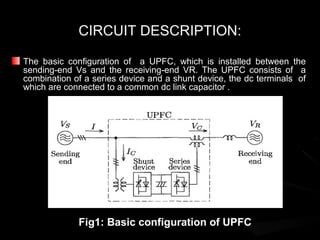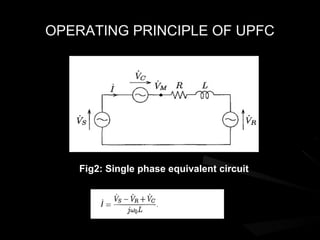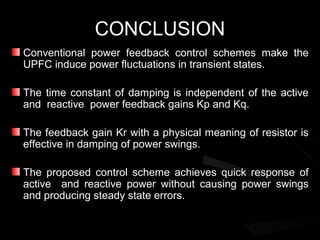upfc
- 1. Unified Power Flow Controller BY Neha Kardam M.Tech (Power System) School Of Engineering Gautam Buddha University, Gr. Noida.
- 2. Contents FACTS devices Benefits of FACTS devices Types of FACTS Devices Introduction to UPFC Circuit Description Control schemes Conclusion
- 3. FACTS Flexible AC Transmission System (Facts) is a new integrated concept based on power electronic switching converters and dynamic controllers to enhance the system utilization and power transfer capacity as well as the stability, security, reliability and power quality of AC system interconnections .
- 4. BENEFITS OF FACTS Regulation of power flows in prescribed transmission routes. Reduces the need for construction of new transmission lines, capacitors and reactors. Provides greater ability to transfer power between controlled areas. These devices help to damp the power oscillations that could damage the equipment.
- 5. Improves the transient stability of the system. Controls real and reactive power flow in the line independently. Damping of oscillations which can threaten security or limit the usable line capacity.
- 6. FACTS Devices Name Type Main function Controller SVC shunt voltage control Thyristor TCSC series power flow control Thyristor TCPAR series & power flow control Thyristor shunt STATCOM shunt Voltage control GTO SSSC series power flow control GTO UPFC shunt & voltage and power GTO series flow control
- 7. INTRODUCTION TO UPFC The UPFC is a device which can control simultaneously all three parameters of line power flow Such "new" FACTS device combines together the features of two "old" FACTS devices: 1. STATCOM 2. SSSC These two devices are two Voltage Source Inverters (VSIŌĆÖs) connected respectively in shunt with the transmission line through a shunt transformer and in series with the transmission line through a series transformer, connected to each other by a common dc link including a storage capacitor.
- 8. The shunt inverter is used for voltage regulation at the point of connection injecting an opportune reactive power flow into the line and to balance the real power flow exchanged between the series inverter and the transmission line. The series inverter can be used to control the real and reactive line power flow inserting an opportune voltage with controllable magnitude and phase in series with the transmission line.
- 9. CIRCUIT DESCRIPTION: The basic configuration of a UPFC, which is installed between the sending-end Vs and the receiving-end VR. The UPFC consists of a combination of a series device and a shunt device, the dc terminals of which are connected to a common dc link capacitor . Fig1: Basic configuration of UPFC
- 10. FUNCTIONAL CONTROL OF SHUNT INVERTER The shunt inverter is operating in such a way to inject a controllable current Ic into the transmission line. This current consist of two components with respect to the line voltage: 1. the real or direct component id 2. reactive or quadrature component iq The direct component is automatically determined by the requirement to balance the real power of the series inverter. The quadrature component, instead, can be independently set to any desired reference level (inductive or capacitive) within the capability of the inverter, to absorb or generate respectively reactive power from the line. So, two control modes are possible: ’āś VAR control mode : the reference input is an inductive or capacitive var request; ’āś Automatic Voltage Control mode: the goal is to maintain the transmission line voltage at the connection point to a reference value.
- 11. FUNCTIONAL CONTROL OF SERIES INVERTER The series inverter injects a voltage, Vse which is controllable in amplitude and phase angle in series with the transmission line. This series voltage can be determined in different ways: Direct Voltage Injection Mode: The reference inputs are directly the magnitude and phase angle of the series voltage. Phase Angle Shifter Emulation Mode: The reference input is phase displacement between the sending end voltage and the receiving end voltage. Line Impedance Emulation Mode: The reference input is an impedance value to insert in series with the line impedance. Automatic Power flow Control Mode: The reference inputs are values of P and Q to maintain on the transmission line despite system changes.
- 12. OPERATING PRINCIPLE OF UPFC Fig2: Single phase equivalent circuit
- 13. (a) Active power control (b) Reactive power control Fig 3: Phasor diagrams in case of active and reactive power
- 14. Control schemes PHASE-ANGLE CONTROL Adjusting the amplitude of the 90" leading or lagging output voltage makes it possible to control active power . The d-q frame coordinates based on space vectors, the d-axis current id corresponds to active power, and so it can be controlled by the q-axis voltage Vcq. Therefore, the reference voltage vector for the series device is given by ŌĆ”ŌĆ”ŌĆ”..
- 15. CROSS-COUPLING CONTROL The "cross-coupling control" has not only an active power feedback loop but also a reactive power feedback loop. This control scheme is characterized by controlling both the magnitude and the phase angle
- 16. GENERALIZED CONTROL SCHEME This "generalized control scheme." The reference voltage vector for the series device, is generalized, as follows A voltage vector produced by the two terms is in phase with the current error vector i*-i. This means that the UPFC acts as a damping resistor against power swings.
- 17. Automatic UPFC
- 18. CONCLUSION Conventional power feedback control schemes make the UPFC induce power fluctuations in transient states. The time constant of damping is independent of the active and reactive power feedback gains Kp and Kq. The feedback gain Kr with a physical meaning of resistor is effective in damping of power swings. The proposed control scheme achieves quick response of active and reactive power without causing power swings and producing steady state errors.
- 19. THANK YOU
